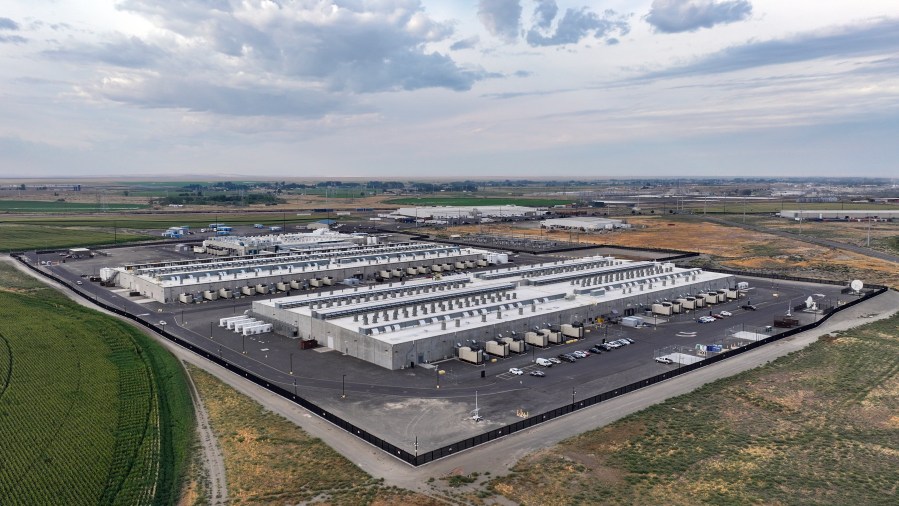President Donald Trump’s initiative to enhance artificial intelligence and establish data centers throughout the United States might lead to a construction rush. This development could challenge the nation’s existing capacity to support such energy consumption, which was already foreseen to be overwhelmed.
Recently, the White House unveiled the “AI Action Plan”, promising to fast-track permits for energy-heavy data centers. This move aims to position the U.S. as a front-runner in a tech sector where hefty investments are pouring in daily.
According to this plan, in order to counter what they call “radical climate dogma,” numerous regulations—including clean air and water statutes—could be weakened, which aligns with Trump’s objective of “American energy dominance” along with efforts to undermine clean energy initiatives.
Here’s what you should know.
Environmental Impact of AI Expansion
To keep up with advancements in AI, data centers require monumental amounts of electricity. The International Energy Agency reports that global electricity consumption by these centers is forecasted to more than double by 2030, reaching levels that slightly surpass Japan’s current overall electricity requirements.
Much of this electricity is likely to be sourced from coal or natural gas, both of which release harmful greenhouse gases like carbon dioxide and methane. Such emissions are linked to increasingly frequent and intense climate-related disasters.

Furthermore, these data centers require a significant amount of water to remain effective and cool, which places additional strain on water supplies in areas that might already be facing shortages.
Big Tech’s Approach to Powering Up
Experts suggest that most tech corporations typically strive to keep existing power plants running to meet energy demands, with most of these facilities in the U.S. still relying predominantly on fossil fuels, especially natural gas.
In certain regions, blending renewable energy sources with storage solutions such as batteries is becoming more prevalent.
On the other hand, exploring nuclear energy holds significant promise in reducing emission levels caused by data center operations while still fulfilling rising demand efficiently.
Recently, Amazon disclosed plans to invest $20 billion into data centers in Pennsylvania, with one facility situated next to a nuclear power plant. This strategy enables direct access to the plant, expediting the company’s project timelines.
Furthermore, Meta has recently entered a partnership to secure nuclear energy for their operational needs. Microsoft is also gearing up to harness power from the famed Three Mile Island nuclear facility, while Google has previously arranged to source energy from several forthcoming small modular reactors.
The Implications of Energy Choices for Data Centers
Data centers are typically established in locations where electricity is most affordable, a lot of which surely doesn’t derive from renewable resources. In many cases, the need for these facilities ends up prolonging the operation of traditional fossil-fuel-powered power plants.
However, just this week, U.N. Secretary-General António Guterres urged the leading tech companies to aim for **totally renewable energy to fuel their data centers by 2030**, emphasizing the critical need to minimize reliance on fossil fuels.
Experts believe that it’s an achievable goal for developers, investors, and the tech sector to shift towards greener operations.
Despite the potential for considerable advancements in clean energy, the burgeoning Power demand is projected to remain too vast for a sustainable solution merely focused on renewables, according to Benjamin Lee, an engineering professor at the University of Pennsylvania.
With the rapid increase of generative AI, ChatGPT, and extended data center infrastructures, making a transition solely to wind, solar, and batteries may become excessively costly. Consequently, the fields are looking into natural gas and nuclear options as viable alternatives.
How AI Expansion Could Raise Your Energy Bills
No matter where the electricity comes from for AI advancements, the straightforward principle of supply and demand suggests that it’s likely prices for consumers will take a hike.
Upcoming data center projects may necessitate both newly generated energy and increased output from existing facilities. Developers might also pour investments into batteries or supplementary infrastructure like transmission lines.
These developments incur costs, and eventually, those expenses must be propagated to users.
“In numerous locations in the U.S., we’re already witnessing hikes in utility rates as energy companies adapt to these emerging demands,” noted Amanda Smith, a senior scientist at Project Drawdown.
Smith elaborated, “They’re planning new transmission networks and power plants to handle the anticipated load, something we truly regard as essential, yet we as utility customers will likely notice an increase in rates to compensate for this.”
Copyright 2025 Nexstar Media, Inc. All rights reserved. This material may not be published, broadcast, rewritten, or redistributed.
For the latest updates, weather forecasts, sports highlights, and streaming content, head over to WGN-TV.




















